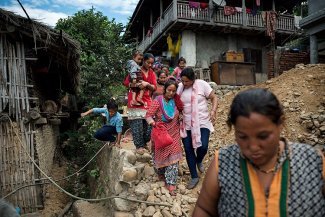
Women attend the closing ceremony of the National Inquiry into Missing and Murdered Indigenous Women and Girls on 3 June 2019 in Gatineau, Quebec, Canada.
As civil society, activists, governments and the United Nations hail 2020 a critical year for advancing women’s rights and gender equality, a femicide crisis in Canada – once a beacon of gender equality – highlights how far there is left to go.
One woman or girl is killed every 2.5 days in Canada – a figure that has not changed in four decades – and a woman is murdered by her partner once a week.
In March, the 64th session of the Commission on the Status of Women will appraise implementation of the Beijing Platform for Action and assess current challenges. Considered the most wide-reaching international framework for advancing women’s rights, the Beijing agenda covers 12 areas of critical concern, violence against women being one.
When the Beijing Agenda was adopted in 1995, Canada held the top spot on the UN’s gender inequality index. By 2015 – the year Justin Trudeau became Prime Minister of Canada’s first self-declared feminist government and gender-balanced cabinet – it had fallen to 25th place.
In 2019, 136 women and girls were killed by violence in Canada. In 59 per cent of cases, the male accused was a current or former intimate partner according to the Canadian Femicide Observatory for Justice and Accountability. The Observatory tracks cases of femicide – which it defines as the killing of women and girls, primarily, but not exclusively, by men – to understand its motivations and circumstances, and thereby help prevent it.
For groups at increased risk of violence, these numbers are no surprise. Particularly for Indigenous women and girls, who experience disproportionate levels of violence, disappearances and murder.
The numbers of missing and murdered Indigenous women and girls, which remains unknown, “is one of Canada’s most shameful realities,” says Vicky Smallman, director of women’s and human rights at the Canadian Labour Congress (CLC). What numbers are available paint an incomplete picture, as many cases have gone unrecorded. Yet some estimates suggest that the number may exceed 4,000 over the past few decades.
The United Nations Special Rapporteur on Violence Against Women, Dubravka Šimonović, noted concern that “indigenous women…faced issues including marginalisation, exclusion and poverty because of institutional, systemic, multiple intersecting forms of discrimination not addressed adequately by the State.”
Canada did not fully adopt the UN’s Declaration on the Rights of Indigenous Peoples until 2016, nearly a decade after it was adopted by the General Assembly. Together, policies like the 19th century Indian Act which is still in effect today, and the media have bred and entrenched apathy, and at times hostility, towards Indigenous people, especially women and girls, resulting in the normalisation of violence and “ungrievable” lives.
Though Indigenous women make up only four per cent of Canada’s population, they are nearly three times more likely to be victims of violence and six times more likely to be killed than non-Indigenous women.
A database compiled by the Native Women’s Association of Canada shows murders of Indigenous women and girls are more likely to go unsolved – only 53 per cent of their cases have led to charges of homicide, compared to 84 per cent of all cases across Canada.
Last year, following two and a half years of hearings, the National Inquiry into Missing and Murdered Indigenous Women and Girls issued its final report calling for transformative legal and social changes, noting “the crisis of violence against Indigenous women and girls has been centuries in the making, and its root cause is colonialism, which runs deep throughout the foundational fabric of this country.”
The inquiry revealed that “persistent and deliberate human and Indigenous rights violations are the root cause behind the staggering rates of violence against Indigenous women” which it said constitutes “raced-based genocide”. The term proved controversial, but Marion Buller, the inquiry’s chief commissioner and a retired Indigenous judge, defended the commission’s decision, saying: “The type of genocide we’re talking about…. it’s death by a million paper cuts.”
Shelters strained
For women and girls fleeing violence, shelters provide a place of protection, and do everything they can to keep women and children safe, says Kaitlin Bardswich, communications and development manager at Women’s Shelters Canada.
Shelters also provide advice, counselling or safety planning through crisis lines, and create ripple effects through the prevention and awareness work they do in communities and schools, Bardswich adds, which helps end violence against women as a whole.
According to Women’s Shelters Canada’s internal database, there are some 550 women’s shelters offering emergency, short or moderate-term stays. However funding issues have had significant repercussions on their work, leaving many strained and struggling to survive. A 2019 report by the organisation on the state of Canada’s women’s shelters found nearly three-quarters report insufficient funding is a huge challenge, while almost half are at capacity all the time.
Stark disparities between rural and urban areas mean access to protection and services is inconsistent.
Rural, remote and northern communities are generally worse off because they have higher rates of violence while also having fewer resources because of sparsely populated areas, Bardswich explains. In Yukon and Nunavut territories, which cover a vast swathe of northern Canada and have higher rates of violence than any of the provinces, there are only three and five shelters, respectively.
Urban areas present different challenges. Canada’s affordable housing crisis has forced many women to stay in shelters longer, causing high turn-away rates due to space constraints – nearly 400 women and over 200 children every day, research has revealed.
Austerity and unequal access
Though Canada has since climbed to 12th place on the UN’s gender inequality index, Smallman says the austerity approach that began in the mid-1990s still drives policymaking today, leading to a wide gap between stated intention and ability to deliver in concrete and lasting ways. “The lack of stable, core funding for women’s rights and feminist organisations continues to be…a considerable barrier to progress and accountability.”
Despite some gains in recent years, Smallman adds, Canada is far from meeting the goals embedded in the Beijing Platform for Action and the 2030 Agenda for Sustainable Development. “It’s possible we could see some movement – but only if well executed. Whether we can move beyond the superficial to meaningful, sustainable change remains to be seen.”
In 2008, the UN called on every country to implement a National Action Plan on Violence Against Women by 2015. Though experts in Canada have been pushing for a plan for years, the government has yet to establish one.
In 2017, the federal government introduced a Strategy to Address and Prevent Gender Based Violence. Widely regarded as a “step forward”, the strategy “has not addressed inequities across the country in services and responses available,” says Myrna Dawson, a sociology professor at the University of Guelph and executive director of the Canadian Femicide Observatory for Justice and Accountability. “This is a problem. Accessing justice or basic services…to address what is now recognised as a public health issue should not depend on who you are or where you live.”
The strategy’s lack of cohesiveness and piecemeal approach was identified by Šimonović following her 2018 mission to Canada. Šimonović called on Canada to adopt a comprehensive, holistic National Action Plan on violence against women, and also advocated for a separate plan that specifically addresses the situation of Indigenous women and girls.
In 2015, 22 national and provincial organisations, including the CLC and Women’s Shelters Canada, issued A Blueprint for Canada’s National Action Plan on Violence Against Women and Girls, since endorsed by 150 other organisations.
Recent signs suggest a National Action Plan may finally be delivered: the current government promised CA$30 million (approximately US$22.6 million or €21 million) towards it in their recent election platform and several ministers were directed to begin work on it in their mandate letters. The job of the CLC now, Smallman says, “is to make sure they do it right, by using the blueprint that we have set out.”
For Dawson, the adoption of a National Action Plan requires political recognition of the problem, political will and a commitment to do something about it. “Given that we have what they themselves have labelled a ‘feminist’ federal government, we’ve been hoping that this will be the period in which it happens. We’re still waiting.”
Challenging complacency
Violence against women was not an issue in the 2019 federal election, and there has not been a debate on women’s rights and gender equity for 35 years.
Last June, the International Labour Organization (ILO) adopted the Convention on Violence and Harassment in the World of Work, the first international treaty of its kind, sending the message that gender-based violence and harassment are pervasive and unacceptable. The CLC played a key role in negotiations, and Smallman is confident that Canada will ratify the Convention. “We just need to make sure it happens in 2020.”
For Dawson, who acknowledges Canada seems more complacent than some other countries, strengthening the women’s movement is vital to addressing femicide.
But the largest challenge for Canada, she adds, lies in addressing the social structures that create and perpetuate conditions conducive to violence. “We need wholescale societal level change and that takes commitment and long-term planning that has so far been absent from our leadership.”
Ending the femicide crisis also requires society to confront their own role in perpetuating violence.
As Niigaan Sinclair, an Anishinaabe writer and associate professor of Native studies at the University of Manitoba, told CBC News last year, everyone needs to be cognisant of the impact colonialism had, and continues to have, on Indigenous people, which has led to a “righteous ignorance” amongst much of Canada’s population.
Moreover, Dawson explains, negative stereotypes, victim-blaming attitudes and perpetrator-excusing beliefs all feed into an environment that facilitates and maintains violence against women and girls. “If you argue that violence is a part of our culture – which I do – then our culture has to change. If it doesn’t, no matter what prevention initiative we try to implement, it will fail.”










